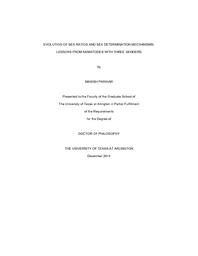
ATTENTION: The works hosted here are being migrated to a new repository that will consolidate resources, improve discoverability, and better show UTA's research impact on the global community. We will update authors as the migration progresses. Please see MavMatrix for more information.
Show simple item record
| dc.contributor.author | Parihar, Manish | |
| dc.date.accessioned | 2017-05-31T19:27:29Z | |
| dc.date.available | 2017-05-31T19:27:29Z | |
| dc.date.issued | 2014-12 | |
| dc.date.submitted | January 2014 | |
| dc.identifier.other | DISS-12924 | |
| dc.identifier.uri | http://hdl.handle.net/10106/26698 | |
| dc.description.abstract | In sexually reproducing species, the decision to allocate resources towards male and female reproductive function is called sex allocation. Although theoretical and empirical work has been largely successful, the underlying mechanisms of sex allocation are not very well known. For instance, little is known about how the parents adjust the sex of the offspring in response to specific environmental conditions. According to Mendel's law of segregation, in species that have two genders, a cross between the male and the female should give an equal proportion of male and female progeny. However, there are some species that deviate from this genetic norm and produce skewed sex ratios. For example, some parasitic nematodes (e.g., Strongyloides) produce exclusively XX females after crossings between XX females and XO males. Although very intriguing, the molecular mechanisms and selective pressures leading to such sex ratio distortions are difficult to study in parasites, as they cannot be cultured outside the host. Here, we are using a free-living nematode species that shows sex ratio distortion and that could be used as a model to understand mechanisms of sex ratio distortion in parasites. For my dissertation, I have uncovered a molecular mechanism in the male germline of the free-living nematode strain SB347 that regulates the sex ratio of the cross progeny. A large proportion of spermatids that can potentially produce males after fertilization are selectively eliminated in the male gonad. Thus, the result of crosses is mostly biased against male offspring. By understanding the mechanisms of sexual allocation and reproduction in free-living nematodes, hopefully new strategies can be created to hamper the propagation of harmful parasites. I have also studied the evolution of sperm size, which seems to correlate with sperm competition in nematodes with three genders - males, females and hermaphrodites. I found that sperm competition is likely to be influenced by several factors, such as availability of females, proportion of hermaphrodites in a population, and production of male-attractant pheromones by females. Unbalanced sex ratios can lead to the evolution of sex determination mechanisms that may restore the equal proportion of sexes. This is one of the reasons thought to drive the rapid evolution of sex determination mechanisms. To understand the mechanisms of sex determination, I also undertook comparative studies between Pristionchus pacificus and Caenorhabditis elegans. | |
| dc.description.sponsorship | | |
| dc.language.iso | en | |
| dc.publisher | Biology | |
| dc.title | Evolution Of Sex Ratios And Sex Determination Mechanisms: Lessons From Nematodes With Three Genders | |
| dc.type | Ph.D. | |
| dc.contributor.committeeChair | | |
| dc.degree.department | Biology | |
| dc.degree.discipline | Biology | |
| dc.degree.grantor | University of Texas at Arlington | |
| dc.degree.level | doctoral | |
| dc.degree.name | Ph.D. | |
Files in this item
- Name:
- Parihar_uta_2502D_12924.pdf
- Size:
- 7.338Mb
- Format:
- PDF
This item appears in the following Collection(s)
Show simple item record


